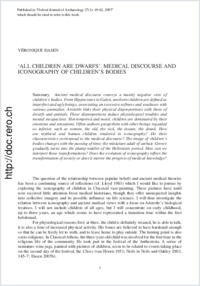"All children are dwarfs": medical discourse and iconography of children's bodies
BHAP-HA+SCANT
- Dasen, Véronique Département des Sciences de l'Antiquité, Université de Fribourg, Suisse
-
08.01.2008
Published in:
- Oxford Journal of Archaeology. - 2008, vol. 27, no. 1, p. 49-62
English
Ancient medical discourse conveys a mainly negative view of children's bodies. From Hippocrates to Galen, newborn children are defined as imperfect and ugly beings, associating an excessive softness and weakness with various anomalies. Aristotle links their physical disproportions with those of dwarfs and animals. These disproportions induce physiological troubles and mental incapacities. Hot-tempered and moist, children are dominated by their emotions and sensations. Often authors group them with other beings regarded as inferior, such as women, the old, the sick, the insane, the drunk. How are mythical and human children rendered in iconography? Do their characteristics correspond to the medical discourse? The image of children's bodies changes with the passing of time; the miniature adult of archaic Greece gradually turns into the plump toddler of the Hellenistic period. How can we interpret these transformations? Does the evolution of iconography reflect the transformation of society or does it mirror the progress of medical knowledge?
- Faculty
- Faculté des lettres et des sciences humaines
- Department
- Département d'histoire de l'art et d'archéologie
- Language
-
- English
- Classification
- Archeology
- License
-
License undefined
- Identifiers
-
- RERO DOC 9770
- DOI 10.1111/j.1468-0092.2007.00295.x
- Persistent URL
- https://folia.unifr.ch/unifr/documents/300831
Statistics
Document views: 191
File downloads:
- pdf: 396
